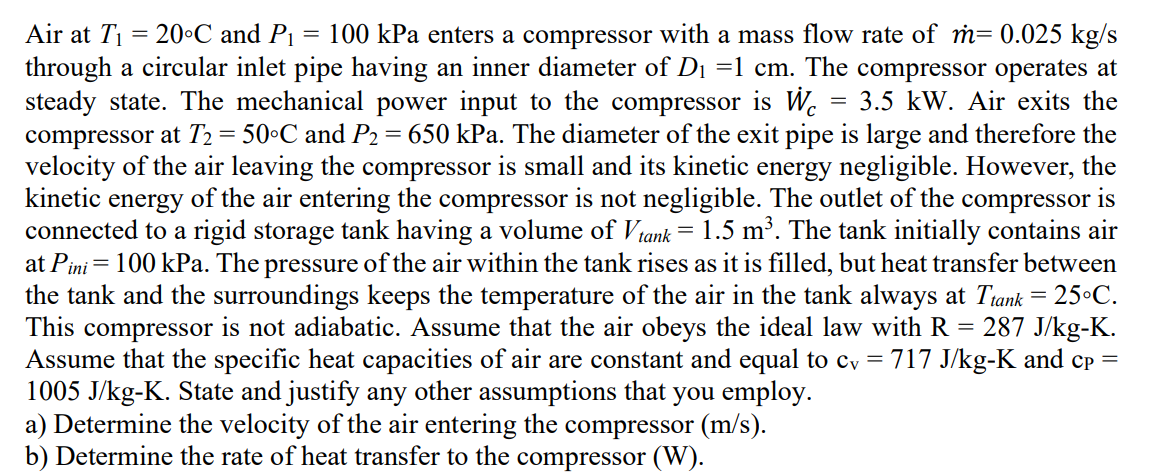Air at T₁ = 20°C and P₁ = 100 kPa enters a compressor with a mass flow rate of m= 0.025 kg/s through a circular inlet pipe having an inner diameter of D₁ =1 cm. The compressor operates at steady state. The mechanical power input to the compressor is W 3.5 kW. Air exits the compressor at T₂ = 50°C and P₂ = 650 kPa. The diameter of the exit pipe is large and therefore the velocity of the air leaving the compressor is small and its kinetic energy negligible. However, the kinetic energy of the air entering the compressor is not negligible. The outlet of the compressor connected to a rigid storage tank having a volume of Vtank = 1.5 m³. The tank initially contains air at Pini = 100 kPa. The pressure of the air within the tank rises as it is filled, but heat transfer between the tank and the surroundings keeps the temperature of the air in the tank always at Ttank = 25°C. This compressor is not adiabatic. Assume that the air obeys the ideal law with R = 287 J/kg-K. Assume that the specific heat capacities of air are constant and equal to cy = 717 J/kg-K and cp = 1005 J/kg-K. State and justify any other assumptions that you employ. a) Determine the velocity of the air entering the compressor (m/s). b) Determine the rate of heat transfer to the compressor (W). =
Air at T₁ = 20°C and P₁ = 100 kPa enters a compressor with a mass flow rate of m= 0.025 kg/s through a circular inlet pipe having an inner diameter of D₁ =1 cm. The compressor operates at steady state. The mechanical power input to the compressor is W 3.5 kW. Air exits the compressor at T₂ = 50°C and P₂ = 650 kPa. The diameter of the exit pipe is large and therefore the velocity of the air leaving the compressor is small and its kinetic energy negligible. However, the kinetic energy of the air entering the compressor is not negligible. The outlet of the compressor connected to a rigid storage tank having a volume of Vtank = 1.5 m³. The tank initially contains air at Pini = 100 kPa. The pressure of the air within the tank rises as it is filled, but heat transfer between the tank and the surroundings keeps the temperature of the air in the tank always at Ttank = 25°C. This compressor is not adiabatic. Assume that the air obeys the ideal law with R = 287 J/kg-K. Assume that the specific heat capacities of air are constant and equal to cy = 717 J/kg-K and cp = 1005 J/kg-K. State and justify any other assumptions that you employ. a) Determine the velocity of the air entering the compressor (m/s). b) Determine the rate of heat transfer to the compressor (W). =
Elements Of Electromagnetics
7th Edition
ISBN:9780190698614
Author:Sadiku, Matthew N. O.
Publisher:Sadiku, Matthew N. O.
ChapterMA: Math Assessment
Section: Chapter Questions
Problem 1.1MA
Related questions
Question

Transcribed Image Text:Air at T₁ = 20°C and P₁ = 100 kPa enters a compressor with a mass flow rate of m= 0.025 kg/s
through a circular inlet pipe having an inner diameter of D₁ =1 cm. The compressor operates at
steady state. The mechanical power input to the compressor is W 3.5 kW. Air exits the
compressor at T₂ = 50°C and P₂ = 650 kPa. The diameter of the exit pipe is large and therefore the
velocity of the air leaving the compressor is small and its kinetic energy negligible. However, the
kinetic energy of the air entering the compressor is not negligible. The outlet of the compressor is
connected to a rigid storage tank having a volume of Vtank = 1.5 m³. The tank initially contains air
at Pini = 100 kPa. The pressure of the air within the tank rises as it is filled, but heat transfer between
the tank and the surroundings keeps the temperature of the air in the tank always at Ttank = 25°C.
This compressor is not adiabatic. Assume that the air obeys the ideal law with R = 287 J/kg-K.
Assume that the specific heat capacities of air are constant and equal to cv = 717 J/kg-K and cp =
1005 J/kg-K. State and justify any other assumptions that you employ.
a) Determine the velocity of the air entering the compressor (m/s).
b) Determine the rate of heat transfer to the compressor (W).
=
Expert Solution
This question has been solved!
Explore an expertly crafted, step-by-step solution for a thorough understanding of key concepts.
This is a popular solution!
Trending now
This is a popular solution!
Step by step
Solved in 2 steps with 2 images

Knowledge Booster
Learn more about
Need a deep-dive on the concept behind this application? Look no further. Learn more about this topic, mechanical-engineering and related others by exploring similar questions and additional content below.Recommended textbooks for you

Elements Of Electromagnetics
Mechanical Engineering
ISBN:
9780190698614
Author:
Sadiku, Matthew N. O.
Publisher:
Oxford University Press

Mechanics of Materials (10th Edition)
Mechanical Engineering
ISBN:
9780134319650
Author:
Russell C. Hibbeler
Publisher:
PEARSON

Thermodynamics: An Engineering Approach
Mechanical Engineering
ISBN:
9781259822674
Author:
Yunus A. Cengel Dr., Michael A. Boles
Publisher:
McGraw-Hill Education

Elements Of Electromagnetics
Mechanical Engineering
ISBN:
9780190698614
Author:
Sadiku, Matthew N. O.
Publisher:
Oxford University Press

Mechanics of Materials (10th Edition)
Mechanical Engineering
ISBN:
9780134319650
Author:
Russell C. Hibbeler
Publisher:
PEARSON

Thermodynamics: An Engineering Approach
Mechanical Engineering
ISBN:
9781259822674
Author:
Yunus A. Cengel Dr., Michael A. Boles
Publisher:
McGraw-Hill Education

Control Systems Engineering
Mechanical Engineering
ISBN:
9781118170519
Author:
Norman S. Nise
Publisher:
WILEY

Mechanics of Materials (MindTap Course List)
Mechanical Engineering
ISBN:
9781337093347
Author:
Barry J. Goodno, James M. Gere
Publisher:
Cengage Learning

Engineering Mechanics: Statics
Mechanical Engineering
ISBN:
9781118807330
Author:
James L. Meriam, L. G. Kraige, J. N. Bolton
Publisher:
WILEY